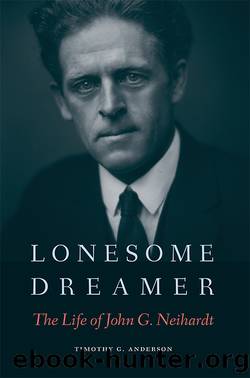Lonesome Dreamer by Timothy G. Anderson

Author:Timothy G. Anderson [Anderson, Timothy G.]
Language: eng
Format: epub
Tags: BIO007000 Biography & Autobiography / Literary
ISBN: 978-0-8032-9037-2
Publisher: Bison Books
Published: 2016-05-23T00:00:00+00:00
11
An Offer Declined and Another Move
John Neihardt had first encountered John Macy in early 1913 when he had thoroughly panned Macyâs book The Spirit of American Literature. Macy was an important literary critic who had worked for the Youthâs Companion and helped edit Helen Kellerâs autobiography, eventually marrying Kellerâs teacher Anne Sullivan. In the book, a survey of the âemergentâ American novelists and poets of the time, Macy proclaimed that the âAmerican spirit in literatureâ was a myth, in the same way that âAmerican valorâ was a myth: the valor of Americans, Macy argued, was no different than that of the Italians or the Japanese.1 He focused on sixteen men working in what he called the American branch of English literature. Neihardt, a true believer in American literature, was not happy with Macyâs opinionsâhis suggestion that James Whitcomb Riley was one of two poets âwho have made literature,â Neihardt thought, was a âPhilistine judgmentââbut what bothered him most was what he saw as Macyâs âimperial manner.â In the end Neihardt concluded that Macy must have been âliving in a trunk for the last ten years.â2
A little more than a decade later, in the spring of 1926, Neihardt read a new Macy book, The Story of the Worldâs Literature, at about the same time Macy was reading Neihardtâs Song of the Indian Wars. This time, both liked what they read: Neihardt gave Macyâs book a glowing review in the Kansas City Journal-Post, calling it âa glorious trip, worth any amount of intellectual shoe leather and a deal of honest panting,â and Macy thought enough of Indian Wars to ask Neihardt to write a book for his new boss, William Morrow.3 Morrow, who had been working in New York publishing for two decades, had just organized his own company, and he wanted a book that explored the American Indiansâ relations with the white population. Macy told Morrow that Neihardt was the man to do it and set about persuading Neihardt to write the book. âYour interest is poetic, and most of your expression is, I believe, in the form of verse,â Macy wrote to Neihardt. âBut would you not be interested to put your experiences into the form of straight prose narrative and exposition of the nature of the Indian, and perhaps go into the history of the breeds that you do not know by personal contact?â4
Neihardt, though flattered, wanted to get to work on his next long narrative poem, one he was envisioning as a continuation of The Song of the Indian Wars, and he had no interest in taking on another prose book. Still, like writers everywhere, Neihardt was occasionally dissatisfied with his regular publisher, and he used Macyâs offer to poke gently at the Macmillan Company: he asked H. S. Latham, Macmillanâs vice president, what he should do about the offer. âI think this letter of Macyâs is a very clever approach in the hope that Morrow may sooner or later publish something for you,â Latham responded, âand I want you to regard Macmillan as your publisher, and not to pass us up for anything.
Download
This site does not store any files on its server. We only index and link to content provided by other sites. Please contact the content providers to delete copyright contents if any and email us, we'll remove relevant links or contents immediately.
Machine Learning at Scale with H2O by Gregory Keys | David Whiting(4025)
Harry Potter and the Goblet Of Fire by J.K. Rowling(3753)
Never by Ken Follett(3735)
Unfinished: A Memoir by Priyanka Chopra Jonas(3285)
Fairy Tale by Stephen King(3178)
The Man Who Died Twice by Richard Osman(2969)
Will by Will Smith(2754)
Rationality by Steven Pinker(2244)
The Dark Hours by Michael Connelly(2201)
It Starts With Us (It Ends with Us #2) by Colleen Hoover(2163)
The Storyteller by Dave Grohl(2146)
Can't Hurt Me: Master Your Mind and Defy the Odds - Clean Edition by David Goggins(2101)
The Dawn of Everything: A New History of Humanity by David Graeber & David Wengrow(2098)
Friends, Lovers, and the Big Terrible Thing by Matthew Perry(2092)
The Becoming by Nora Roberts(2048)
The Stranger in the Lifeboat by Mitch Albom(2023)
Cloud Cuckoo Land by Anthony Doerr(2009)
Love on the Brain by Ali Hazelwood(1925)
Einstein: His Life and Universe by Walter Isaacson(1921)
